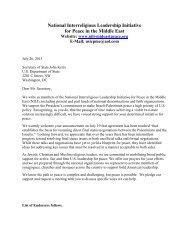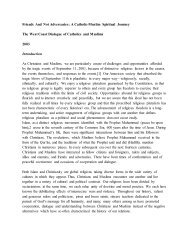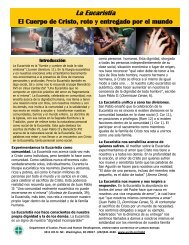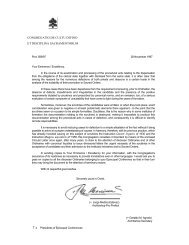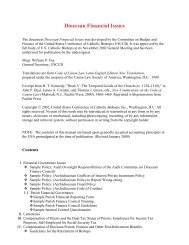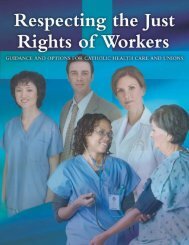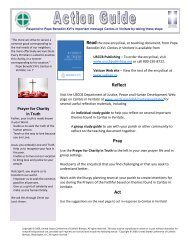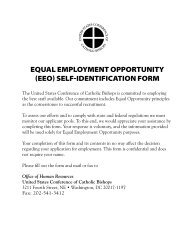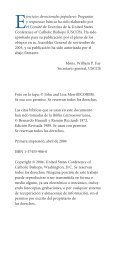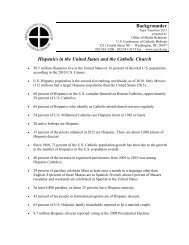Doctrinal Elements of a Curriculum Framework for the Development ...
Doctrinal Elements of a Curriculum Framework for the Development ...
Doctrinal Elements of a Curriculum Framework for the Development ...
- No tags were found...
You also want an ePaper? Increase the reach of your titles
YUMPU automatically turns print PDFs into web optimized ePapers that Google loves.
1. Lowered age <strong>of</strong> First Communion to age <strong>of</strong> reason.2. Popularized Gregorian chant—helped liturgicalmovement.B. Opposed “modernism.”14. The Church and <strong>the</strong> World WarsA. Pope Benedict XV and World War I—seven-pointpeace plan.B. Pope Pius XI.1. Signed Lateran Treaty with Mussolini; broke withMussolini in 1931.2. His break with Hitler—encyclical Mit BrennenderSorge.C. Pope Pius XII.1. Opposed Nazis; Christmas messages <strong>for</strong> peace.2. Pius and <strong>the</strong> Jews—his ef<strong>for</strong>ts to protect <strong>the</strong>m.3. Spiritual signs <strong>of</strong> light in darkness <strong>of</strong> war andits aftermath—1954 proclaimed dogma <strong>of</strong> <strong>the</strong>Assumption—encyclicals.15. Vatican Council II: A Pastoral Approach to <strong>the</strong>WorldA. Pope John XXIII—his pastoral vision <strong>for</strong> <strong>the</strong> Council(see his opening speech at Council: Gaudet MaterEcclesia [Rejoice, O Mo<strong>the</strong>r Church], October 11, 1962).B. The Council documents—pastoral tone and language.C. Pope Paul VI (1963).1. Guided remaining sessions <strong>of</strong> Council.2. Implemented Council teachings.3. Controversy over Humanae Vitae.4. Met with A<strong>the</strong>nagoras in Istanbul.5. Visits to New York, Bombay, Manila, etc.6. Promoted synods <strong>of</strong> bishops.7. Succeeded by Pope John Paul I, who reigned thirtythreedays.D. Some developments after <strong>the</strong> Council.1. Changes in liturgy, growth <strong>of</strong> Scripture study,new look in church architecture, growth <strong>of</strong> layinvolvement—parish councils, etc.2. Liturgical movement, work by Catholic Action,and work by Scripture scholars preceded Counciland enabled its implementation.3. <strong>Development</strong>s in catechesis; understanding <strong>the</strong>need <strong>for</strong> both content and <strong>for</strong>mation.4. Call to evangelization—Evangelii Nuntiandi.5. Renewal <strong>of</strong> <strong>the</strong> Eastern Churches.16. Pope John Paul II: The Church Looks to <strong>the</strong> Twenty-First CenturyA. First non-Italian pope in centuries—vigorous, dramatic,faced down Communism.B. Evangelizer to <strong>the</strong> world: 104 papal trips overseas, hisDialogue <strong>of</strong> Salvation.C. Teacher: numerous encyclicals, post-synodaldocuments, writings.1. Fides et Ratio, Evangelium Vitae, Veritatis Splendor.2. Wednesday talks on Genesis—<strong>the</strong>ology <strong>of</strong> <strong>the</strong>body.D. Pastor: Holy Thursday letters to priests—his WorldYouth Days.E. Themes: be not afraid; Mary, Totus Tuus; human dignity,new evangelization.F. Assassination attempt: example <strong>of</strong> courage, faith,and <strong>for</strong>giveness.G. The Catechism <strong>of</strong> <strong>the</strong> Catholic Church.17. Pope Benedict XVIA. First encyclical Deus Caritas Est followed by apostolicexhortation Sacramentum Caritatis.B. Addresses clash <strong>of</strong> culture and civilization with faith.C. Ecumenism today: Church <strong>of</strong> <strong>the</strong> East, OrientalOrthodox, Eastern Orthodox, Protestant.18. The Church in <strong>the</strong> United StatesA. Colonial America.1. French-speaking Catholics—Jesuit explorers,missions, martyrs.2. Spanish-speaking Catholics—Junipero Serra, etc.3. English colonial Catholics—Archbishop JohnCarroll.B. Immigrations—ethnic Catholics.1. Second-class citizens; Church supports workingclass.2. Catholic school and hospital systems—religiousorders.3. Parish as center <strong>of</strong> social life; patriotism gainsacceptance.C. Church’s role in development <strong>of</strong> social justice in <strong>the</strong>United States.1. Cardinal Gibbons and implementation <strong>of</strong> <strong>the</strong>Church teaching on workers in <strong>the</strong> late nineteenthand early twentieth century.2. Church support <strong>of</strong> labor unions’ fight <strong>for</strong> rights<strong>of</strong> workers.3. The Depression and its effects.D. Eastern Catholics.1. Establishment <strong>of</strong> hierarchies.2. Presence today.E. Catholic education.38<strong>Doctrinal</strong> <strong>Elements</strong> <strong>of</strong> a <strong>Curriculum</strong> <strong>Framework</strong> <strong>for</strong> <strong>the</strong><strong>Development</strong> <strong>of</strong> Catechetical Materials <strong>for</strong> Young People <strong>of</strong> High School Age



